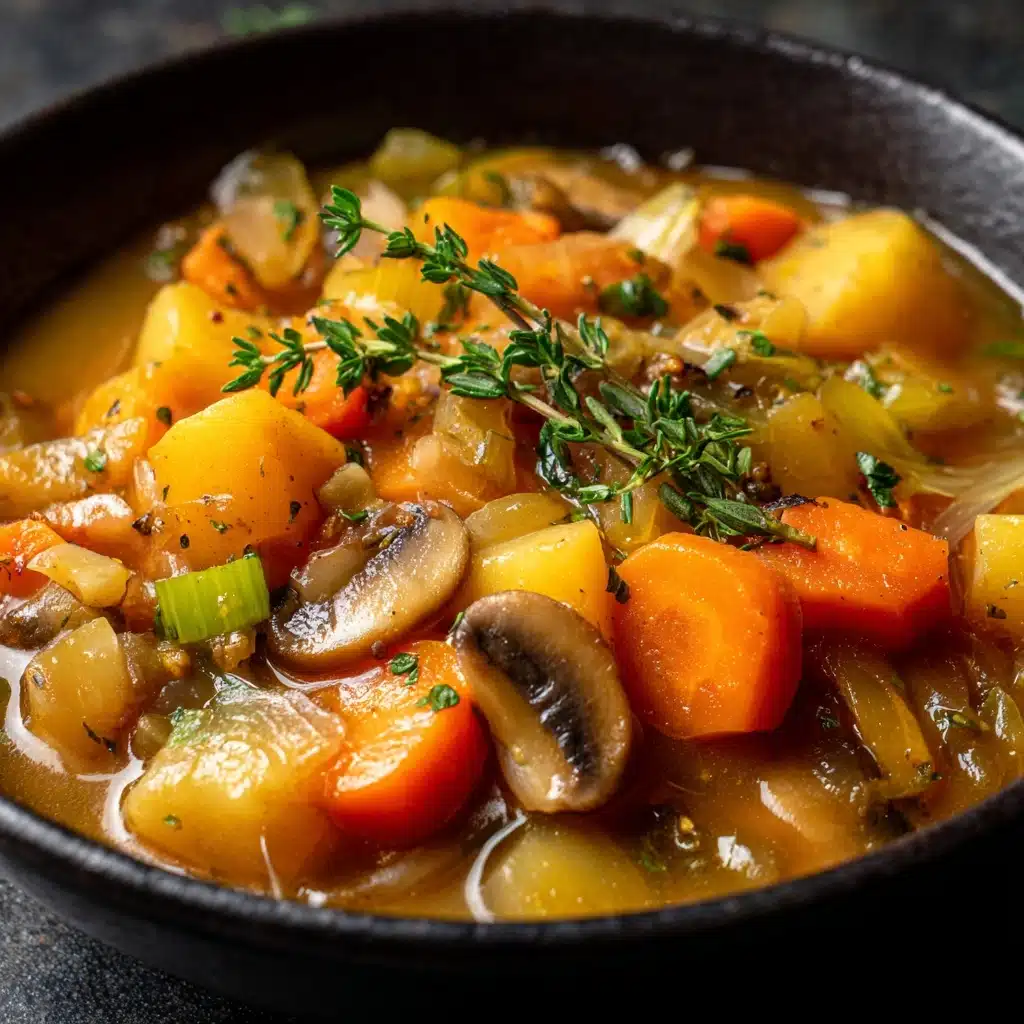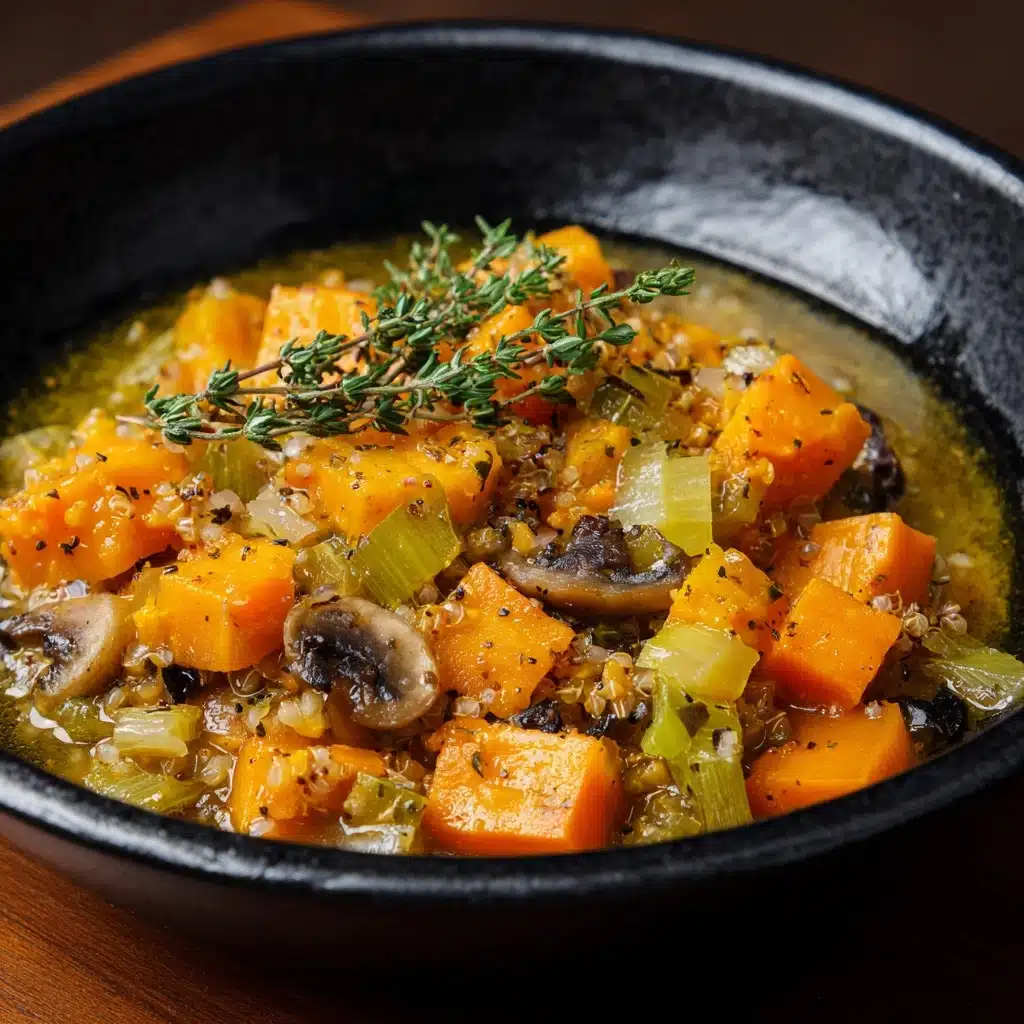There’s something magical about tucking into a bowl of Colonial Vegetable Pottage Recipe—a true taste of early America that blends old-world comfort with farmhouse-style simplicity. This rustic stew overflows with root vegetables, vibrant herbs, and a light, nourishing broth, creating soul-warming flavors in every spoonful. If you’re searching for a hearty dish steeped in history and packed with seasonal goodness, this is the homestyle meal you’ll want bubbling on your stove.

Ingredients You’ll Need
The beauty of the Colonial Vegetable Pottage Recipe lies in its humble ingredients, all pulling their weight to produce rich depth and satisfying textures. Each element has a distinct purpose, whether it’s adding sweetness, fortifying the broth, or painting the pot with color. Here’s what you’ll need to gather:
- Butter or olive oil (2 tablespoons): This creates a luscious base for sweating the vegetables and infuses richness into the dish.
- Medium onion, chopped (1): Brings natural sweetness and aromatic savor.
- Garlic cloves, minced (2): Adds earthy undertones and subtle heat.
- Carrots, sliced (2): For a gentle sweetness and gorgeous color.
- Parsnips, peeled and diced (2): Old-fashioned, peppery, and the secret to extra flavor depth.
- Celery stalks, chopped (2): Delivers crunch and a bright, grassy note.
- Medium potatoes, peeled and cubed (2): Lend satisfying body and creaminess.
- Turnip, peeled and diced (1): A slightly sharp counterpoint that keeps things rustic.
- Small cabbage, shredded (½): Softens into the pottage, sweet and savory.
- Vegetable broth or water (6 cups): Builds a flavorful or classic base for the stew.
- Dried thyme (1 teaspoon): Essential for herby warmth and aroma.
- Dried sage (½ teaspoon): Complements the earthiness of the root vegetables.
- Salt (½ teaspoon): Just enough to wake up all the flavors.
- Black pepper (¼ teaspoon): Brings a subtle kick.
- Bay leaf (1): Adds mild bitterness and complexity.
- Chopped parsley (optional, for garnish): For a fresh finish and pop of green.
How to Make Colonial Vegetable Pottage Recipe
Step 1: Sweat the Aromatics
Start by melting the butter or warming the olive oil in a large, heavy-bottomed pot over medium heat. Add the chopped onion and minced garlic. Sauté these together for 2 or 3 minutes until they become fragrant and translucent—this is your flavor foundation! The kitchen starts smelling amazing right away.
Step 2: Build the Vegetable Base
Toss in the carrots, parsnips, celery, potatoes, turnip, and cabbage. Stir well, making sure all the vegetables are coated with the buttery goodness and begin to soften. Let them sauté for another 5 to 7 minutes; this draws out their natural sweetness and gives the pottage its signature heartiness.
Step 3: Simmer the Pottage
Pour in the vegetable broth (or water, if you’re feeling truly old-school), then add the dried thyme, sage, salt, pepper, and bay leaf. Give the whole pot a gentle stir. Crank up the heat to bring the pot to a beautiful boil, then dial it down to a low simmer. Cook uncovered for 30 to 40 minutes, until the veggies are fork tender and the broth is silky and fragrant.
Step 4: Finish and Serve
Fish out the bay leaf—that’s done its job of infusing subtle flavor. Taste your Colonial Vegetable Pottage Recipe and adjust seasoning if it needs a touch more salt or pepper. Just before serving, sprinkle with fresh chopped parsley if you have it on hand. Ladle generously into bowls, and serve piping hot!
How to Serve Colonial Vegetable Pottage Recipe

Garnishes
A sprinkle of bright green parsley over each bowl is the classic finishing touch for this Colonial Vegetable Pottage Recipe. If you want extra herbal freshness, thinly sliced chives or a handful of microgreens can also complement the earthiness of the stew beautifully.
Side Dishes
Nothing says comfort like pairing this pottage with thick slices of crusty bread, ideally rustic rye or sourdough to soak up the savory broth. You could also serve it with a wedge of sharp farmhouse cheese on the side, or a light green salad for contrast.
Creative Ways to Present
For a charming, colonial-inspired presentation, serve the pottage in wide earthenware bowls, perhaps with a few rustic croutons on top. If you’re entertaining, consider ladling the stew into golden-brown baked bread bowls or serving individual portions in mason jars for a whimsical, pioneer touch.
Make Ahead and Storage
Storing Leftovers
The Colonial Vegetable Pottage Recipe is just as delicious the next day, making it a fantastic make-ahead option. Let leftovers cool to room temperature, then transfer to an airtight container and refrigerate for up to 4 days. The flavors will actually deepen as they mingle!
Freezing
This stew freezes beautifully. Once completely cooled, portion the pottage into freezer-safe containers or heavy-duty freezer bags. Label and freeze for up to three months. Just remember that potatoes can change texture a bit after freezing, but the flavor remains spot-on.
Reheating
To bring the pottage back to life, simply reheat gently on the stovetop over medium-low heat, stirring occasionally, until hot throughout. Add a splash of water or broth if it has thickened a bit too much. It’s just as inviting as when freshly made!
FAQs
Can I use different vegetables in the Colonial Vegetable Pottage Recipe?
Absolutely! Colonial cooks made pottage with whatever they had on hand, so feel free to swap in sweet potatoes, rutabaga, leeks, or even mushrooms based on what’s available or in season.
Is Colonial Vegetable Pottage Recipe vegan?
If you use olive oil and select vegetable broth, this recipe is naturally vegan. The butter option presents a vegetarian (and delicious) twist, so tailor it to your dietary needs.
Can I add protein to make it more filling?
Definitely! Stir in cooked lentils, chickpeas, or even a handful of peas during the last 10 minutes of simmering. These additions boost both protein and heartiness, making it a complete meal.
How can I adjust the seasoning?
Seasoning the Colonial Vegetable Pottage Recipe is all about balancing the herbs with a bit of salt and pepper. If you like more herbal punch, try a pinch more thyme or sage, or finish with a dash of vinegar or squeeze of lemon juice for brightness.
Can I make this recipe in a slow cooker?
Sure! Sauté the aromatics as directed, then transfer everything into your slow cooker. Cook on low for 6 to 7 hours, or on high for around 3 hours, until all the vegetables are meltingly tender and flavors are well developed.
Final Thoughts
There’s a reason the Colonial Vegetable Pottage Recipe has survived centuries on American tables—it’s wholesome, flexible, and deeply satisfying in any season. Whether you’re seeking simple comfort food or craving a little brush with history, this is one meal you’ll want to revisit again and again. Give it a try, and enjoy a taste of true colonial coziness!
Print
Colonial Vegetable Pottage Recipe
- Total Time: 55 minutes
- Yield: 6 servings 1x
- Diet: Vegetarian, Gluten-Free
Description
A comforting and historic Colonial Vegetable Pottage recipe that brings the flavors of early American colonies to your table. This hearty vegetable stew is easy to prepare and perfect for a cozy meal.
Ingredients
Vegetable Pottage:
- 2 tablespoons butter or olive oil
- 1 medium onion (chopped)
- 2 cloves garlic (minced)
- 2 carrots (sliced)
- 2 parsnips (peeled and diced)
- 2 stalks celery (chopped)
- 2 medium potatoes (peeled and cubed)
- 1 turnip (peeled and diced)
- 1/2 small cabbage (shredded)
- 6 cups vegetable broth or water
- 1 teaspoon dried thyme
- 1/2 teaspoon dried sage
- 1/2 teaspoon salt
- 1/4 teaspoon black pepper
- 1 bay leaf
- chopped parsley for garnish (optional)
Instructions
- Saute Aromatics: In a large pot, heat butter or olive oil over medium heat. Add the onion and garlic and cook until softened.
- Add Vegetables: Stir in carrots, parsnips, celery, potatoes, turnip, and cabbage. Cook for 5–7 minutes.
- Cook Soup: Add broth, thyme, sage, salt, pepper, and bay leaf. Simmer for 30–40 minutes until vegetables are tender.
- Finish and Serve: Remove bay leaf, adjust seasoning, and garnish with parsley. Serve hot with bread.
Notes
- This dish reflects a common meal in early American colonies.
- Adjust vegetables based on availability or add legumes like lentils for protein.
- Prep Time: 15 minutes
- Cook Time: 40 minutes
- Category: Main Course
- Method: Stovetop
- Cuisine: American (Colonial)
Nutrition
- Serving Size: 1 1/2 cups
- Calories: 160
- Sugar: 6 g
- Sodium: 500 mg
- Fat: 6 g
- Saturated Fat: 2 g
- Unsaturated Fat: 3 g
- Trans Fat: 0 g
- Carbohydrates: 24 g
- Fiber: 5 g
- Protein: 3 g
- Cholesterol: 5 mg







